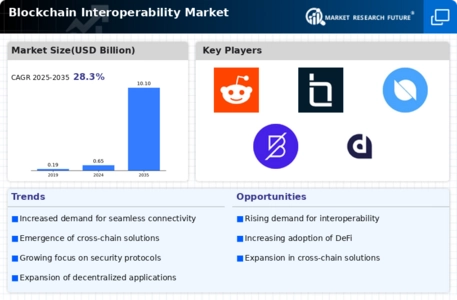Market Growth Projections
Rising Demand for Cross-Chain Solutions
The Global Blockchain Interoperability Market Industry experiences a notable surge in demand for cross-chain solutions. As enterprises increasingly adopt multiple blockchain platforms, the need for seamless communication and data exchange between these systems becomes paramount. This trend is evidenced by the projected market growth from 0.65 USD Billion in 2024 to an anticipated 10.1 USD Billion by 2035. The compound annual growth rate (CAGR) of 28.37% from 2025 to 2035 indicates a robust interest in technologies that facilitate interoperability, allowing businesses to leverage the strengths of various blockchain networks while minimizing operational silos.
Regulatory Support and Standardization Efforts
The Global Blockchain Interoperability Market Industry benefits from growing regulatory support and standardization initiatives. Governments and regulatory bodies are increasingly recognizing the potential of blockchain technology, leading to efforts aimed at creating frameworks that promote interoperability. These initiatives may include guidelines for data sharing and collaboration between different blockchain networks. As the market evolves, such regulatory frameworks could enhance trust and security, encouraging broader adoption. The anticipated growth from 0.65 USD Billion in 2024 to 10.1 USD Billion by 2035 suggests that regulatory clarity will play a crucial role in shaping the future of interoperability solutions.
Increased Adoption of Decentralized Finance (DeFi)
The Global Blockchain Interoperability Market Industry is significantly influenced by the rising adoption of decentralized finance (DeFi) applications. DeFi platforms often require interoperability to enable users to access a wide range of financial services across different blockchains. As of 2024, the market is valued at 0.65 USD Billion, with projections suggesting a substantial increase to 10.1 USD Billion by 2035. This growth is driven by the need for users to transfer assets seamlessly between various DeFi protocols, thereby enhancing liquidity and user experience. The interoperability solutions that facilitate these transactions are likely to see increased investment and development in the coming years.
Technological Advancements in Blockchain Protocols
The Global Blockchain Interoperability Market Industry is propelled by rapid technological advancements in blockchain protocols. Innovations such as atomic swaps, sidechains, and cross-chain bridges are emerging as pivotal solutions to enhance interoperability. These technologies enable different blockchain networks to communicate and transact with one another, thereby expanding the utility of blockchain applications. The market is expected to grow from 0.65 USD Billion in 2024 to 10.1 USD Billion by 2035, reflecting a growing recognition of the importance of interoperability in maximizing the potential of blockchain technology. As these advancements continue, they are likely to attract significant investment and development.
Growing Interest in Blockchain for Supply Chain Management
The Global Blockchain Interoperability Market Industry is increasingly driven by the growing interest in blockchain applications for supply chain management. Companies are exploring blockchain to enhance transparency, traceability, and efficiency in their supply chains. Interoperability between different blockchain systems allows for better data sharing and collaboration among stakeholders, which is essential for optimizing supply chain operations. The market's growth from 0.65 USD Billion in 2024 to 10.1 USD Billion by 2035 indicates a rising recognition of the value that interoperability brings to supply chain solutions. As organizations seek to integrate various blockchain platforms, the demand for interoperability solutions is likely to escalate.















